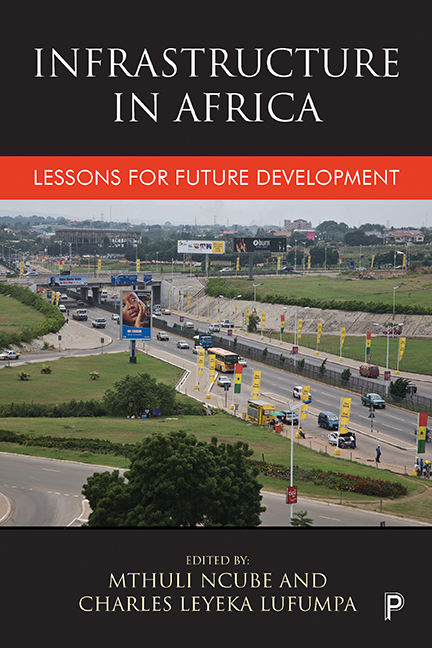Book contents
- Frontmatter
- Contents
- List of figures
- List of tables
- List of boxes
- Notes on contributors
- Acknowledgements
- Foreword
- Introduction: Infrastructure in African development
- Part 1 Spatial and demographic contexts
- Part 2 Sector-specific issues
- Part 3 Regional issues
- Part 4 Financing issues
- Part 5 Concluding remarks
- Index
three - Infrastructure for the growing middle class in Africa
Published online by Cambridge University Press: 05 April 2022
- Frontmatter
- Contents
- List of figures
- List of tables
- List of boxes
- Notes on contributors
- Acknowledgements
- Foreword
- Introduction: Infrastructure in African development
- Part 1 Spatial and demographic contexts
- Part 2 Sector-specific issues
- Part 3 Regional issues
- Part 4 Financing issues
- Part 5 Concluding remarks
- Index
Summary
Introduction
During the first years of the century Africa experienced one of the highest growth rates in the world, even overcoming the financial crisis. The regional annual gross domestic product (GDP) growth rate climbed from 3% before 2000 to 6.5% in 2007. However during the following period and recent crisis, falling commodity prices, and lower export volumes, tinted perspectives for slower growth, which the continent seem to be managing well as real GDP growth in 2015 was 3.6%.
The African success has been accompanied with poverty reduction. The transformation suffered by Africa during recent years has reflected in an increase in trade, investment, and purchasing power of African households, as well as in the reduction of poverty. South Africa, Zambia, Ghana and Uganda were among the countries with highest poverty reductions (World Bank, 2009). In some countries poverty decreased by 7% between 1990 and 2005.
Economic growth and poverty reduction entangle the growth of the middle class in all countries. In absolute terms, the middle class is defined as the population with a daily consumption between US$2 and US$20 (2005 Purchasing Parity Power [PPP]). It is composed of three different sub-classes. Individuals with consumption level between US$2 and US$4 per day, belong to the “floating class”, just above the regular poverty line. Those with per capita consumption levels of US$4 to US$10 per day are the “lower-middle class” and finally the “uppermiddle class” is composed of people with per capita consumption levels of US$10-US$20 per day (Mubila and Aissa, 2011). In relative terms, the middle class is composed by the population within the second, third and fourth quintile of the income or expenditure distribution.
Between 1980 and 2010 the middle class grew from 26% of the total population to 34%.The most dynamic group within the middle class is the “floating class”. Not only has the “floating class” grown but the middle classes have also decreased during the past 20 years without sustained increases in the upper class. The relative high weight of the floating class implies some vulnerability of the middle class. Figure 3.1 shows the evolution of the “floating class” against the rest of the middle class. Between 1980 and 2010 the middle class reduced its participation from 15% to 13% in total population; the upper class remained at 5% after having increased to 7% by 2000, while the floating class jumped from 12% to 21%.
- Type
- Chapter
- Information
- Infrastructure in AfricaLessons for Future Development, pp. 111 - 136Publisher: Bristol University PressPrint publication year: 2017

